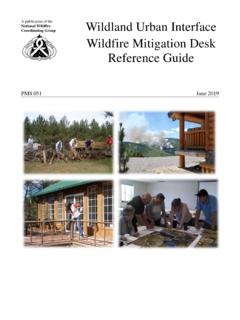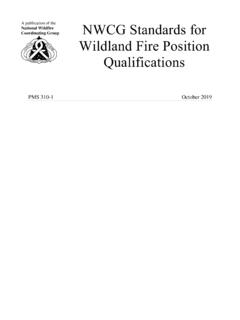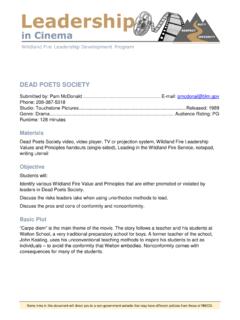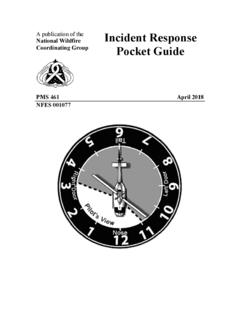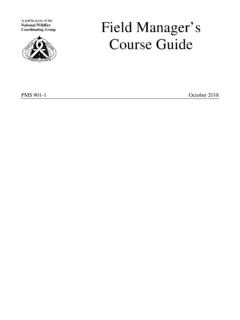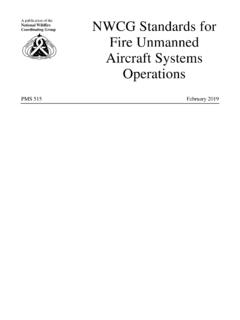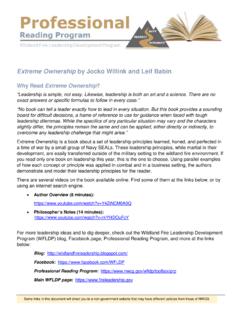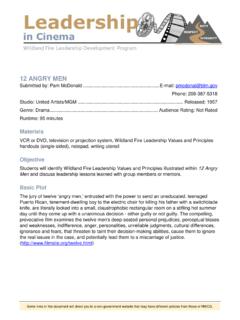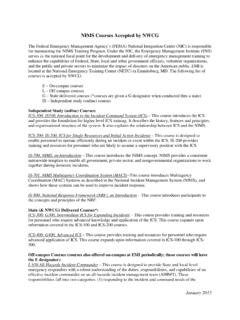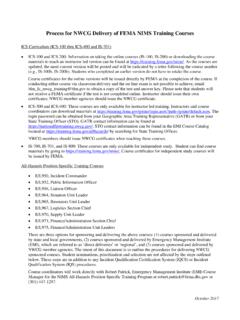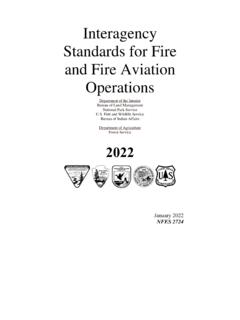Transcription of NWCG Standards for Recognition of Prior Learning (RPL ...
1 A publication of the National Wildfire Coordinating Group NWCG Standards for Recognition of Prior Learning (RPL) PMS 309 JANUARY 2022 The National Wildfire Coordinating Group (NWCG) provides national leadership to enable interoperable wildland fire operations among federal, state, tribal, territorial, and local partners. NWCG operations Standards are interagency by design; they are developed with the intent of universal adoption by the member agencies. However, the decision to adopt and utilize them is made independently by the individual member agencies and communicated through their respective directives systems. NWCG Standards for Recognition of Prior Learning (RPL) January 2022 PMS 309 The NWCG Standards for Recognition of Prior Learning (RPL) establishes the use of a formal competency-based qualification process that allows any credentialing authority to recognize and account for competence acquired through life-long Learning and experience.
2 RPL is a process that evaluates an individual s formal and non-formal Learning to determine the extent to which that individual has achieved the required competencies to perform effectively in a specific emergency management or responder position . It is widely recognized that a standardized NWCG RPL process will reduce redundant training, support efforts to increase speed and time to competency, and support efforts to boost national resource surge capacity. Federal agencies with responsibilities under the National Response Framework (NRF) are required to ensure that emergency response providers, incident management personnel, and any other personnel responding to a disaster declaration are credentialed and typed in accordance with 6 320. Homeland Security Presidential Directive 5 (HSPD-5) also sets minimum Standards that emergency responders must meet.
3 Although local, state, tribal, and private sector partners are not required to be credentialed under these Standards , as the primary first responders to any national disaster they are strongly encouraged to be fully credentialed. Many of these local first responders already hold some level of qualification in their current position . RPL is a tool that provides a means of achieving the more universal all risk credentialing of local and state-level responders and managers currently credentialed within their agencies. The benefit of having nationally credentialed local and state resources throughout the nation assures greater efficiency and effectiveness of multi-agency, multi-jurisdictional coordination when disasters occur. NWCG member agencies, including state, local, and tribal, which participate in national wildfire response in the federal system under a Master Cooperative wildland fire Management and Stafford Act Response Agreement are required to be credentialed under NWCG position qualifications.
4 Several federal and state NWCG members and the All-Hazards Incident Management Teams Association (AHIMTA) have developed successful RPL processes. It is widely recognized that a standardized NWCG RPL process will reduce redundant training, support efforts to increase speed and time to competency, and support efforts to boost national resource surge capacity. NWCG Standards for Recognition of Prior Learning (RPL) i Table of Contents Section 1: National Disaster Response .. 1 Section 2: National Incident Management System .. 1 Section 3: Definition of Credentialing .. 1 Section 4: Qualification .. 1 Section 5: RPL Definition .. 2 Section 6: Competency Versus Performance-Based Qualifications .. 2 Section 7: Basic Tenets of RPL .. 2 Section 8: NWCG position Competencies .. 3 Section 9: Home Unit/Agency.
5 3 Section 10: Home Unit/Agency Responsibilities for use of 3 Section 11: Initiating the Use of RPL in the Credentialing Process .. 3 Section 12: Application for the use of RPL in Credentialing .. 4 Section 13: Candidate s Portfolio .. 4 Section 14: Evaluation Panel .. 4 Section 15: Evaluator Qualifications .. 5 Section 16: Evaluation Process .. 5 Section 17: Assessing the Portfolio .. 5 Section 18: Evaluation Interview .. 5 Section 19: Check References .. 6 Section 20: Determination of Competency .. 6 Section 21: Decision Process .. 6 Section 22: 6 Section 23: Appeal Process .. 7 Section 24: Summary of Minimum Standards and Recommendations .. 7 NWCG Standards for Recognition of Prior Learning (RPL) 1 of 8 Section 1: National Disaster Response September 11, 2001, demonstrated to America that, as emergency responders and emergency managers, we must plan, train, and exercise to respond together, thus assuring a coordinated, efficient, and effective response to all threats.
6 A coordinated and effective response requires the multiple disciplines of our emergency management and emergency response systems, federal to state to local, be credentialed to a single standard, position by position . Section 2: National Incident Management System Mandated by Homeland Security Presidential Directive 5 (HSPD-5), Management of Domestic Incidents, and as outlined in the National Incident Management System (NIMS) Federal Emergency Management Agency (FEMA) P -501, NIMS provides a consistent nationwide template to enable federal, state, tribal, and local governments, and the private sector to work together to respond to and recover from the effects of incidents, regardless of cause, size, or complexity. HSPD-5 requires NIMS training for all federal emergency responders working in support of the NRF.
7 To ensure unity of effort, NIMS advocates Standards to include training, experience, credentialing, validation, and physical and medical fitness. Federal, state, tribal, and local certifying agencies, and professional and private organizations with personnel involved in emergency management and incident response are encouraged to credential those individuals in their respective disciplines or jurisdictions. RPL recognizes the NIMS requirements for specified training for the purpose of all-hazards response. Section 3: Definition of Credentialing NWCG recognizes the definition of credentialing from the Department of Homeland Security/FEMA as referred to by the Homeland Security Act of 2002 and Recommendations of the 9/11 Commission Act of 2007. This language provides: The terms credentialed and credentialing mean having provided, or providing, respectively, documentation that identifies personnel and authenticates and verifies the qualifications of such personnel by ensuring that such personnel possess a minimum common level of training, experience, physical and medical fitness, and capability appropriate for a particular The credentialing process entails the objective evaluation and documentation of an individual s competence or proficiency to meet nationally accepted Standards .
8 This can take the form of current certification, licenses, degrees, training, and/or experience. Section 4: Qualification NWCG qualifications are typically position -specific. The NWCG Standards for wildland fire position Qualifications, PMS 310-1, , shall be the guiding document for NWCG qualifications essential for a position and should be part of a job task analysis. During the NWCG RPL process, this analysis should incorporate input from job incumbents, managers, industry, and others with knowledge of the position requirements. Use of RPL for NWCG position qualification shall not circumvent or minimize course and training requirements for specific positions, as defined in the most current edition of PMS 310-1. NWCG Standards for Recognition of Prior Learning (RPL) 2 of 8 Section 5: RPL Definition RPL is a competency-based process that evaluates an individual s experience, formal and non-formal, to determine the extent to which that individual has achieved the required competencies of an emergency response position .
9 RPL is a qualification process used to determine a person s competency to do a job at a prescribed level for the basis of credentialing. RPL measures the candidate s demonstrated knowledge, skills, and experience (the overall performance) against national standard competencies established for specific jobs. The evaluation process focuses on candidates ability to meet the established Standards rather than how they acquired the knowledge, skills, or abilities. Candidates may have acquired their skills in another emergency response/services discipline, through formal training in a particular field, in the military, or through a combination of career employment experiences. Candidates should not be judged on where or how they learned to do a job, but rather their ability to do the job. Section 6: Competency Versus Performance-Based Qualifications 1.
10 In a performance-based qualification system, qualification is based on completion of required training and demonstrated successful position performance by completing a position Task Book (PTB). The primary criterion for qualification is the individual s performance as observed by a qualified evaluator. The PTB contains all critical tasks required to perform the job. The process of demonstrating the abilities to perform the position is the completion of a PTB. Many of the tasks being evaluated may require they be observed during an actual incident. 2. In a competency-based system for credentialing, a candidate demonstrates to qualified evaluators the competencies required to perform the job adequately. Skills are evaluated holistically using the combined knowledge, skills, and abilities required to demonstrate the level of competency in performing the job.
